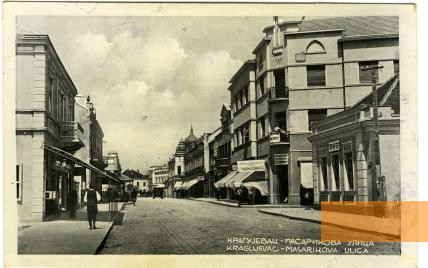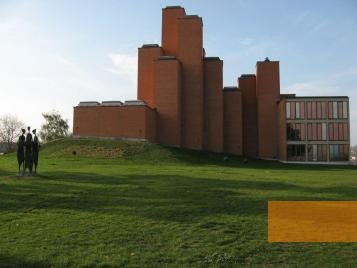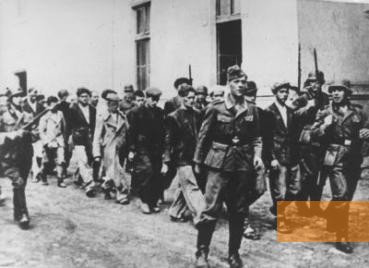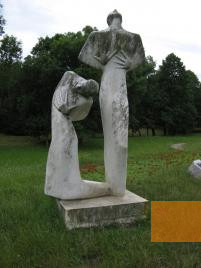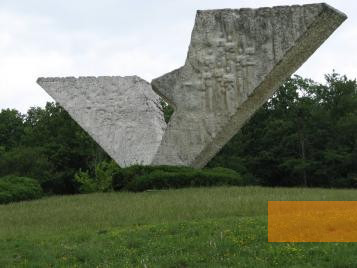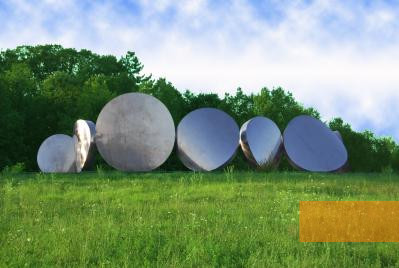A memorial park and the »October 21« memorial site in Kragujevac, one of the largest cities in Serbia, honour the approximately 2,300 civilians who were shot by the German Wehrmacht on October 21, 1941.
In April 1941, the German Wehrmacht and its allies invaded Yugoslavia. The country was divided
: German troops took the largest part of what is today Serbia. A resistance movement against the occupiers soon formed; numerous partisan groups fought against the Wehrmacht. The commanding general in Serbia, Franz Böhme, issued an order on October 10, 1941, by which civilians were to be »punished« for attacks on German soldiers. From then on, one hundred civilians were shot for every killed German; every injured soldier prompted the killing of fifty civilians. In mid-October 1941, partisan units attacked a German battalion near Kragujevac, killing ten soldiers, injuring 26 more. The attacked battalion returned to Kragujevac on October 18, 1941. »Reprisal measures« were immediately set in motion by the battalion and the troops of infantry regiment 724 under the Major Paul König: the Wehrmacht arrested all those suspected of being communists and all Jewish men, a total of 66 people. Members of infantry regiments 724 and 749 subsequently burned down several villages in the area of Kragujevac, killing 422 men. On October 20, the troops returned to the city. In order to meet Böhme's demands of 2,300 killed civilians, Wehrmacht soldiers began to arbitrarily arrest Serbian men. The soldiers also broke into schools and rounded up the pupils and teachers. About 3,000 of those arrested were held in the barracks courtyard. On the morning of October 21, 1941, the soldiers started shooting men and young boys on the city outskirts, stopping only once the number of victims reached 2,300.
: German troops took the largest part of what is today Serbia. A resistance movement against the occupiers soon formed; numerous partisan groups fought against the Wehrmacht. The commanding general in Serbia, Franz Böhme, issued an order on October 10, 1941, by which civilians were to be »punished« for attacks on German soldiers. From then on, one hundred civilians were shot for every killed German; every injured soldier prompted the killing of fifty civilians. In mid-October 1941, partisan units attacked a German battalion near Kragujevac, killing ten soldiers, injuring 26 more. The attacked battalion returned to Kragujevac on October 18, 1941. »Reprisal measures« were immediately set in motion by the battalion and the troops of infantry regiment 724 under the Major Paul König: the Wehrmacht arrested all those suspected of being communists and all Jewish men, a total of 66 people. Members of infantry regiments 724 and 749 subsequently burned down several villages in the area of Kragujevac, killing 422 men. On October 20, the troops returned to the city. In order to meet Böhme's demands of 2,300 killed civilians, Wehrmacht soldiers began to arbitrarily arrest Serbian men. The soldiers also broke into schools and rounded up the pupils and teachers. About 3,000 of those arrested were held in the barracks courtyard. On the morning of October 21, 1941, the soldiers started shooting men and young boys on the city outskirts, stopping only once the number of victims reached 2,300.
Wehrmacht soldiers shot about 2,000 residents of Kragujevac. Among the victims were many children and youths aged between 12 and 18. 205 Roma, inhabitants of the city whose names are known today, were also among the victims.
The memorial park »October of Kragujevac« was set up in 1953. Architects Mihailo Mitrović and Radivoje Tomić laid out a six-kilometre-long circular path along which numerous monuments by well-known artists have been erected. The most prominent monument is the memorial to the executed pupils and teachers, also known as the »Broken Wing« monument. In 1976, the »October 21« memorial and museum, designed by architects Ivan Antić and Ivanka Raspopović, was opened. The windowless red brick building comprises 33 towers of different heights and houses an exhibition. The ground plan of the building is in the form of a Christian cross.
At the end of 1979, the memorial was declared a cultural heritage of great importance.
Germans were not allowed to visit the memorial in the first year of its existence. It was not until the end of the 1950s that visitors from the GDR (German Democratic Republic) were welcomed, and it took another two decades until the first delegation from West Germany visited the memorial.
Since 1971, a »Great School Lesson« is held annually on October 21 in the memory of the pupils and the teachers who were murdered here on that day in 1941. Many prominent performing artists have participated in the ceremonies since then.
The building of the museum had been damaged in the war of 1999, so that for several years the museum had to be closed for construction works.
At the end of 1979, the memorial was declared a cultural heritage of great importance.
Germans were not allowed to visit the memorial in the first year of its existence. It was not until the end of the 1950s that visitors from the GDR (German Democratic Republic) were welcomed, and it took another two decades until the first delegation from West Germany visited the memorial.
Since 1971, a »Great School Lesson« is held annually on October 21 in the memory of the pupils and the teachers who were murdered here on that day in 1941. Many prominent performing artists have participated in the ceremonies since then.
The building of the museum had been damaged in the war of 1999, so that for several years the museum had to be closed for construction works.
- Name
- Memorial Park »Kragujevački Oktobar«
- Address
-
Desankin venac b.b.
34000 Kragujevac - Phone
- +381 (0) 34 335 607
- Fax
- +381 (0) 34 336 112
- Web
- http://www.spomenpark.rs/
- info@spomenpark.rs
- Open
- From 15 April to 31 October: Monday to Saturday 8 a.m. to 6 p.m.,
on state holidays and Sundays 9 a.m. to 4 p.m.
From 1 November to 14 April daily 9 a.m. to 4 p.m.
Closed on 1 January - Possibilities
- Permanent exhibition, archive, library


